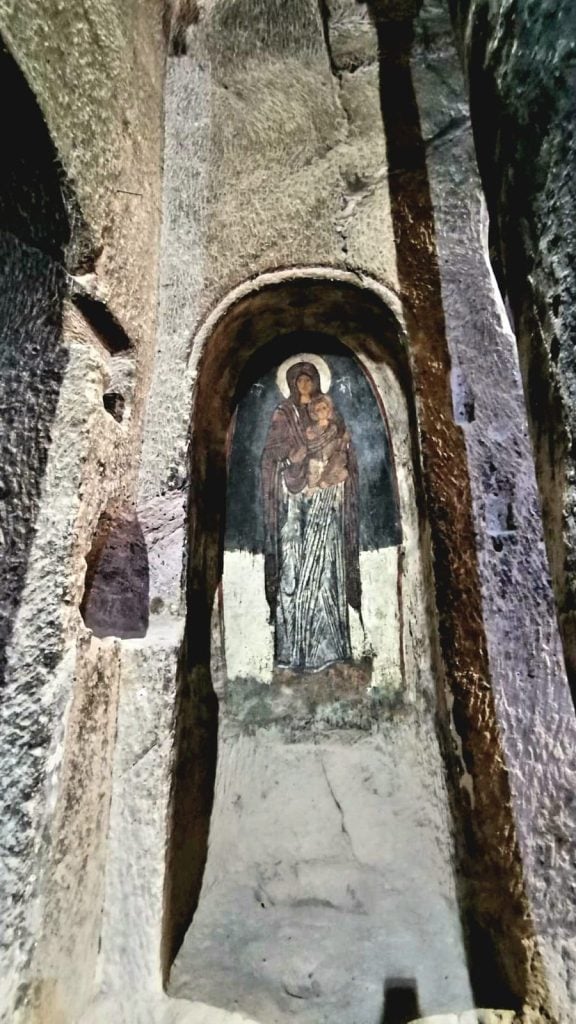Gümüşler Monastery: Exploring an Ancient Treasure in Niğde, Türkiye
Gümüşler Monastery: Exploring an Ancient Treasure in Niğde, Türkiye
Gümüşler Monastery is located near the town of Gümüşler, which is affiliated with Niğde province in Turkey. Gümüşler Monastery is situated 8 km away from Niğde in the town of Gümüşler. It is one of the historical and cultural treasures of Niğde.
Timeless Wonders: The Enchanting Frescoes and Architectural Grandeur of Gümüşler Monastery
Gümüşler Monastery served as an important monastic center during the Christian period. The history of the structure dates back to the Byzantine era, and the frescoes inside the monastery reflect the artistic and architectural features of that period.
There are no historical sources available about the medieval name and history of Gümüşler town where the monastery is located. Carved into a large rock church, the monastery has survived well to the present day in the Cappadocia region and is one of the largest monasteries. It is one of the finest and best-preserved examples of Byzantine art in Anatolia.
Step Back in Time: Unraveling the Secrets of Gümüşler Monastery in Niğde, Turkey
Many monasteries carved into the rock can be found in Cappadocia, and some scholars classify them into two groups: those with a dining hall (trapezalı) and those with an open courtyard. Gümüşler Monastery falls into the second group. The most important structure of the monastery is the church, located to the north of the complex. The church has a cruciform plan with four free-standing columns. There are two burial niches to the north of the northern cross arm, two vaulted entrance rooms to the west of the naos. The functions of many other spaces in the monastery remain unknown.
Designated as an archaeological site in 1973, the monastery was meticulously carved into a large and wide rock mass. The walls of the church are covered with frescoes. The powerful and vivid narratives depicted in the frescoes, the presence of an underground city, a large burial chamber, and residential units carved into a massive rock mass, all point to the significance of Gümüşler as an important religious center of its time.
Gümüşler Monastery: A Journey Through Christian Heritage in the Heart of Turkey
It is believed that at least three different artists worked on the wall paintings of the church. The uppermost tier of paintings in the main apse features Jesus on the Throne, accompanied by two angels and symbols of the Gospel writers. The Desis scene includes depictions of Mary and the Apostles. The lower tier showcases portraits of church fathers like Basil of Caesarea, Gregory of Nyssa, and Gregory of Nazianzus.
Gümüşler Monastery, dating back to the 10th century, continued its construction between the 8th and 12th centuries. Inside the church, you will find exceptionally well-preserved, vibrant colored frescoes portraying scenes such as the birth of Jesus, his baptism, presentation to the church, Apostles, and prominent figures of Christianity.
The scenes of the Annunciation, the Nativity of Jesus, and the Presentation to the Temple, as well as the figures of John the Baptist and Saint Stephen in the northern cross arm, are believed to have been created by a second artist. The third artist is attributed to the figures of Mary with the child Jesus, flanked by the archangels Gabriel and Michael, located on the south side of the entrance gate from the inner narthex to the naos. An unusual composition of hunting scenes with various animals can be seen on the walls of a room above the narthex, which is not seen in other examples in Cappadocia. Like many other churches in Cappadocia, the frescoes in Gümüşler Monastery can be dated based on their iconographic and stylistic features. The paintings can be dated back to the 11th and 12th centuries using this method.
Hidden Gem of Niğde: Discovering the Rich History of Gümüşler Monastery
Gümüşler Monastery offers visitors an opportunity to embark on a historical journey and explore the beautiful nature of rural Turkey. If you are interested in history and cultural heritage and plan to visit the Niğde region, Gümüşler Monastery should be on your list of must-see places. However, keep in mind that it is important to check for up-to-date information and visiting hours from local sources before your visit.
Reference;Niğde Directorate of Culture and Tourism Brochure

